Follow these twelve tips to improve your climbing speed and ability.
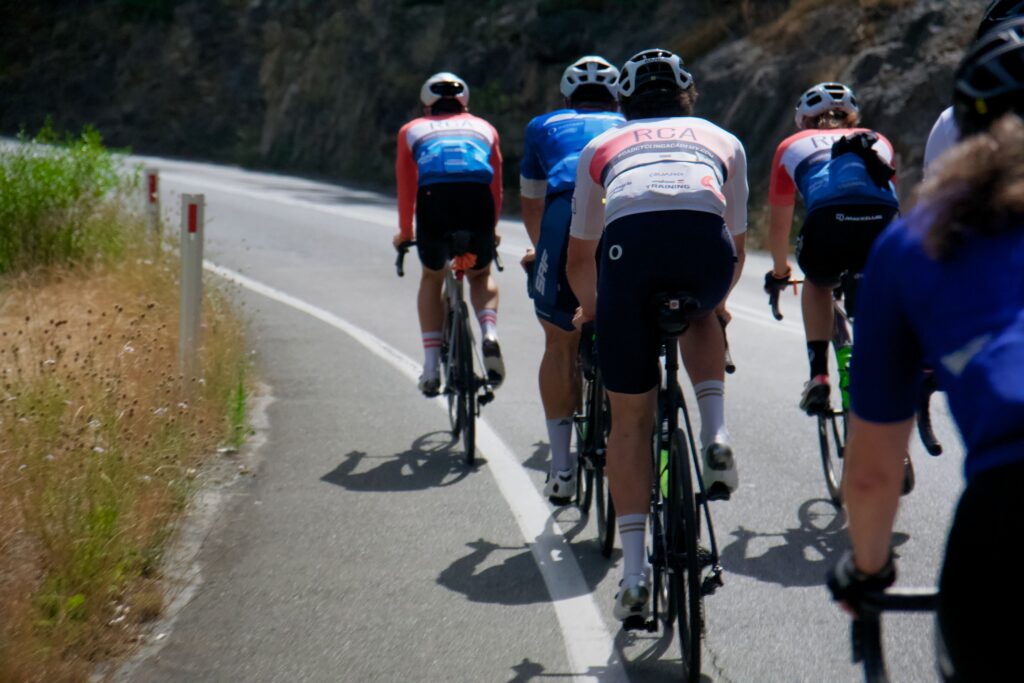
You’re riding with your local group or a friend, and suddenly their voice gets further and further away — you begin breathing at an uncomfortable rate, you start rocking side-to-side and up and down, and you don’t know where to place your hands on the bars for maximum power and comfort.
At this point, your technique is out the window, and you’re just trying to make it up the climb. You’d kill for more power on the pedals.
Improving your climbing technique and ability will make cycling more enjoyable. You’ll also be able to keep up with local riders and not have to shout ahead, telling them that “you’ll catch up on the downhill.”
Avoid grinding to a halt and witnessing your form break down by improving your climbing ability — there are numerous ways to do it, but we’ve got twelve tips to help you tackle those tough climbs without straying away from the group.
Key takeaways:
- Don’t neglect core and strength training
- Adopt the right technique
- Add more hill training to your cycling (steep hills, long hills, etc.)
Download the RCA core exercises e-book for better climbing.
How to get better at climbing cycling
There are several things you can do to improve your climbing, from choosing the right gear ratios to improving your hill climbing technique, fuelling correctly, and off-bike training, such as strength and conditioning exercises.
So, whether you’re planning a trip to the mountains or you’d like to attempt a Tour de France effort on one of your favourite long climbs, we’ve got you covered.
Some ways to get better at climbing are more obvious than others, but we recommend the following cycling tips:
- Start strength training
- Improve your VO2 Max and anaerobic endurance
- Focus on technique
- Lose weight (if necessary)
- Use the right gears
- Pace yourself correctly
- Get used to climbing — do more of it
- Give yourself more energy
- Have a plan of attack
- Perform hill repeats
- Add variety to your training
- Prioritise training your core
Continue reading to find out more about each method — you’ll go from being out of breath to admiring the beauty of a steep gradient. Well, maybe not quite, but you get the point.
Start strength training
We know we should do it, but for many cyclists, the thought of lifting weights in the gym is not as exciting as riding your bike.
Although, as little as three weeks of strength training can improve strength on the bike and cycling efficiency [3]. A period of eight weeks plus, however, is more likely to show better results, including improvements in maximal strength and power output, cycling efficiency and economy, and increased time to exhaustion while cycling [9,11].
Basic exercises to get started include the leg press, half squats, and body weight exercises such as hanging knee raises.
However, if you’re unsure where to begin or how to perform each exercise, you can check out our top gym exercises for cyclists with expert cycling strength coach, Aaron Turner.
Improve your VO2 Max and anaerobic endurance
Aerobic training is the main energy system used by road cyclists. But often, many people forget that in any one given ride, you also tap into the anaerobic energy system multiple times — especially when tackling steep climbs. Both aerobic and anaerobic endurance are important determinants for cycling performance [10].
VO2 Max, on the other hand, is your maximal uptake of oxygen during maximal exercise [4]. It’s a common measurement taken to determine the size of an athlete’s aerobic capacity and overall potential.
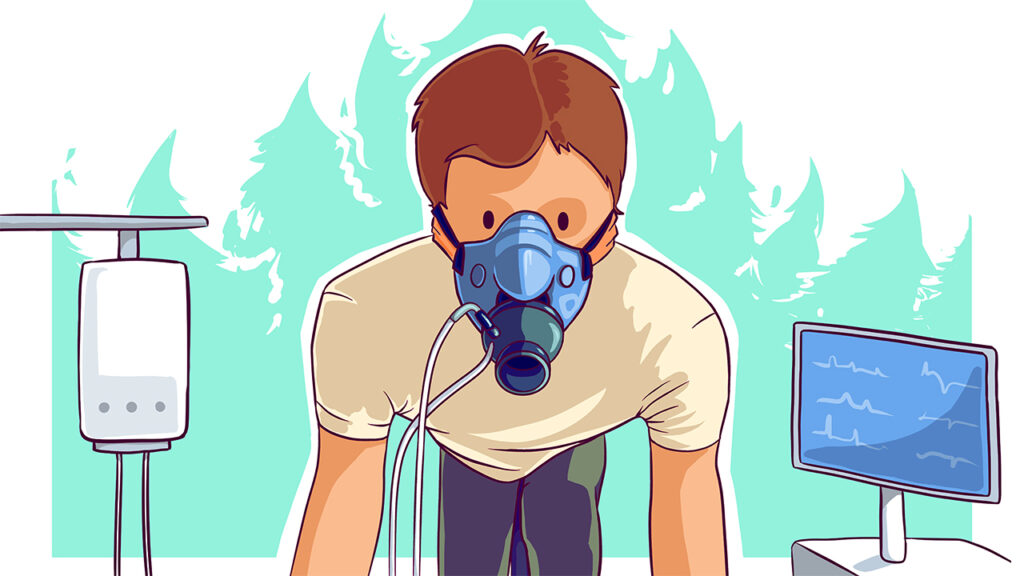
To increase your VO2 Max, perform zone 2 training — including long rides — paired with shorter hill repeat efforts at 110-125% of your functional threshold power (FTP) for 3-5 minutes. Likewise, to improve your anaerobic endurance on the bike, perform long sprints and/or efforts greater than 130% of your FTP.
It should be noted that strength training also increases fractional utilisation of VO2 Max and improves cycling economy [10] — another reason not to skip off-bike training.
Improving your aerobic and anaerobic energy systems will equate to better climbing.
Focus on technique
Technique matters — but you might only notice this once you’re fatigued. You know the signs, so why not focus on improving your technique so you can minimise fatigue and maximise performance for better climbing on the bike.
When you reach a climb, should you stay seated or stand? Current research finds body position (seated vs. standing) to have an insignificant effect on external efficiency during cycling [5]. But most notably, standing produces a greater force per pedal revolution, perhaps the better option on intense gradients. Despite this, standing may block certain determining factors affecting metabolic responses.
Switching between the two positions is likely the better option — it recruits different muscles. Standing helps tackle those shorter climbs with very steep gradients, and alternating between in and out of the saddle efforts recruits different muscle groups to combat fatigue.
Lose weight (if necessary)
Weight loss is a tricky topic to discuss in the world of cycling. But when we talk about climbing, it’s a necessary discussion to have.
Think of it like this: you have two riders, one is carrying a 20kg sack of potatoes on his back, and the other is not. Who is going to reach the top of the hill first? Chances are, it’s the rider without the extra weight.
But it’s not a case of just losing weight — you need to have a good power-to-weight ratio — that’s your power output (watts) divided by your weight (kg).
For most riders, there’s a sweet spot for optimal climbing — that’s being light enough to climb quickly, but strong enough to put enough power through the pedals to get them up those longer climbs.
Look at any intensive climbing stage of a race, and you’ll often find the lighter riders performing better than others. It’s what they’re designed for.
Please note: If you’re looking to lose weight, please do it safely and slowly.
For an effective but simple approach to weight loss, check out our video with sports dietitian, Steph Cronin.
To lose weight, you’ll need to enter a calorie deficit — expend more calories than you consume — of roughly 200 to 500 calories.
It’s a good practice to weigh yourself weekly to see if you’re losing weight too quickly. In which case, you can adjust your nutrition as needed to achieve gradual weight loss progress.
Use the right gears
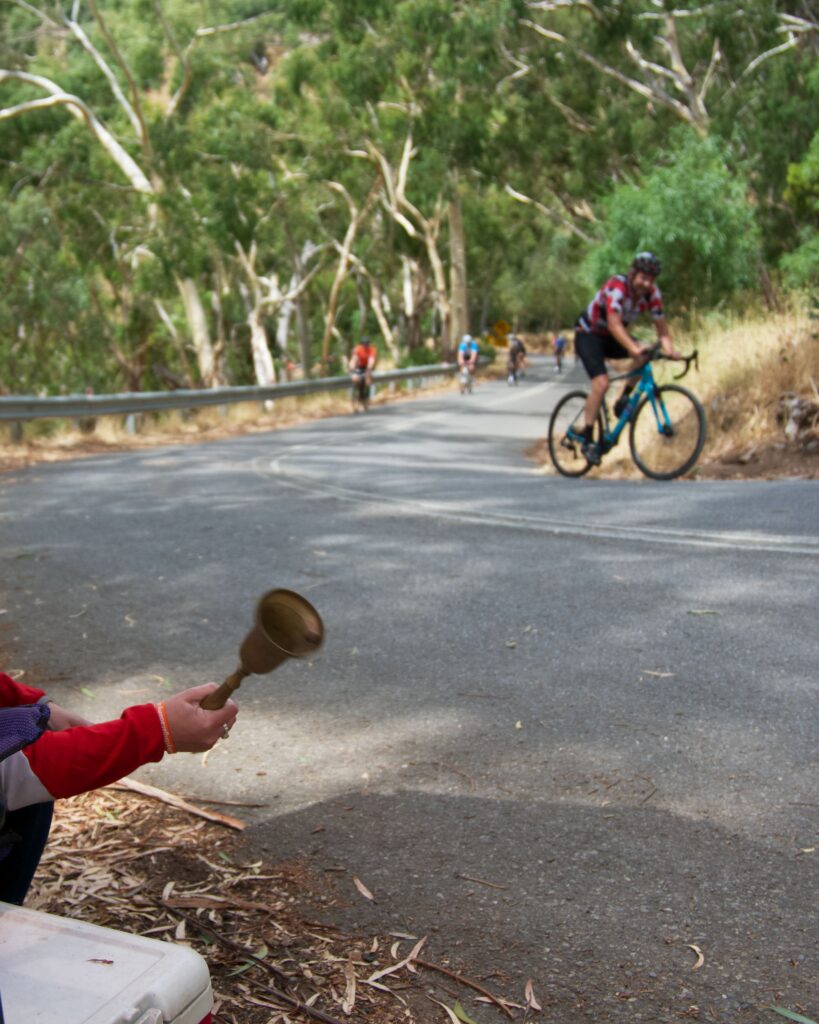
When the road starts to tilt up, you’ll want to switch to a low gear.
If the gradient is short and steep, you can likely get away by switching gears in the back of the cassette (upwards).
But if the climb is long and steady (or very steep in places), you’ll want to drop the chain to the smallest chainring in the front and the largest cog in your cassette (the big gear) on the back.
If you use the wrong gears, you’ll struggle to push on the pedals and will expend unnecessary energy.
Instead, focus on achieving a quicker cadence at a more sustainable pace.
You can use a cadence sensor to view your cadence in real time while climbing. However, most power metres also measure cadence. It’s less about how you measure your cadence, and more about what you do with those numbers.
Pace yourself correctly
It’s all too easy to attack longer climbs too early, only to run out of energy, wishing you had a lower gear.
The better you learn how to pace yourself, the better climber you’ll become.
There are numerous ways to ensure successful pacing. For example, you can use:
- A power metre to measure your given power
- Cadence sensors to track your RPM
- A heart rate monitor to track your effort (although a power metre is more accurate)
- Maps on your bike computer to see how long a climb is (and what %)
- Monitor your perceived exertion (how tired you feel)
You can also switch between staying seated and standing to alternate what muscles are used. This is a good habit to implement, even on those long climbs.
If you start a climb and you are familiar with your power and heart rate numbers, think about what you can sustain for a given duration? For example; you are starting a 10 minute climb, and your best 10 minute power within the last couple of months is 300w. If you start riding at 350w, you are going to fatigue very quickly and be on your hands and knees by the top! But if you start at 280w, you are well within your limits and can go easier or harder depending on the situation – you have wiggle room and will be more comfortable!
Get used to climbing — do more of it!
Climbing ability often comes down to practice — the more you do it, the better you’ll get.
So instead of avoiding those big climbs, start riding them.
You’ll build confidence, leg strength, muscular endurance, and a bigger aerobic capacity.
And the next time you ride with your mates, you’ll have earned the bragging rights to deliver the infamous line, “I’ll wait for you at the top, mate.”
As well as climbing more hills and tackling big climbs, you can perform hill repeats.
Perform hill repeats
Hill repeats are an excellent training session for working the upper-end zones, increasing VO2 Max, muscular strength, and becoming more efficient at tolerating and utilising lactate.
Regular hill reps performed at a low cadence, in particular, may improve cycling performance and muscular strength and endurance [6].
So, what is the correct way to perform a hill reps session? Check out the video below for a how-to guide with Cam.
And if you’re already performing hill repeats, the below tips will help you get the most out of each session. But these are also discussed in the above video.
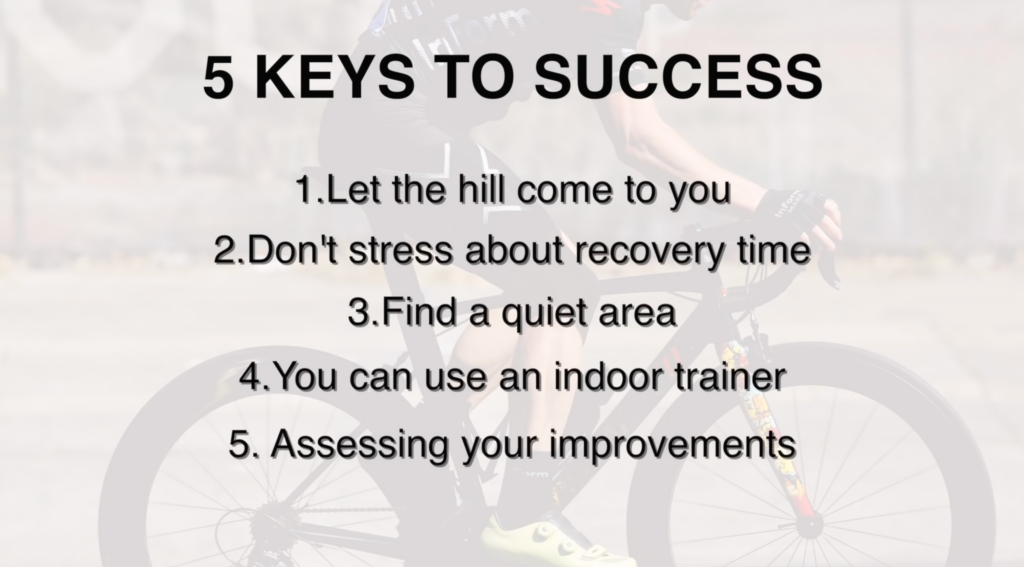
Give yourself more energy
To avoid the dreaded bonk, make sure to fuel correctly during your ride.
If you’re riding for more than 1 hour, it’s a good idea to consume approximately 30 – 60 grams of carbohydrates/hour.
That can include whole foods such as jam sandwiches or more convenient options such as rice bars, energy gels, or even carbohydrate mixes you add to water and drink on the go.
But what’s more important here is that you’re eating often and replenishing those energy stores.
Not having enough fuel will make those big climbs, in particular, even more difficult.
Have a plan of attack
If your plan of attack is: attack. Then you might want to re-think your strategy.
The more you know about the climb, the better. You can use your bike computer to assess the elevation and other key details such as climb length, and so on.
If you’re planning a long day in the saddle, use GPS data to find what climbs are on your route. Scope them out, find the steepest sections, the average gradient, any areas that might give you a little trouble.
Arm yourself with as much knowledge as you can. The more you know about a climb, the better.
This makes the attack that much easier.
Add variety to your training
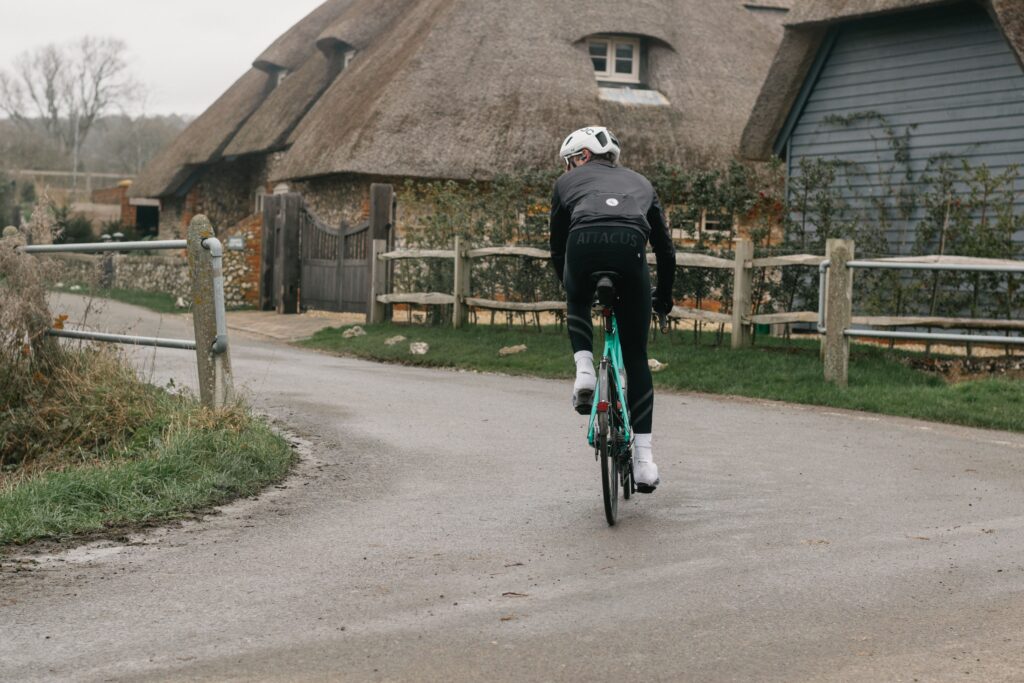
While specific sessions such as hill repeats stimulate type 2 fast twitch fibres and other anaerobic (and aerobic developments), you should add variety to your training.
For example, the following sessions will help you not only get better at climbing, but will help you become a better and more efficient cyclist:
- Weekly long rides
- High cadence and low cadence drills
- Short explosive efforts and longer efforts
- Train your core strength & upper body
Prioritise training your core to improve your climbing performance
While the above tips are the usual prescribed methods for improving your climbing, one of the more overlooked training aspects is specialised core training. Instead of leaving core exercises to the end of a regular strength session, you should train them individually and like you would any other muscle for better results.
Prioritising specialised core training, such as targeting the musculature around the hip and trunk, equates to improved trunk and hip stability in cyclists [7]. The lumbopelvic-hip complex (LPHC) serves as a direct energy transfer along the kinetic chain — improve stability and strength in these areas to directly improve postural control and energy transfer [2].
By improving core strength, you also reduce your risk of injury by reducing fatigue on the bike, i.e. you’re less likely to practise poor cycling mechanics when tired [1].
Good starting exercises include the bird dog, single-leg deadlifts, a standard plank, and a side plank [6,7]. But if you’d like further advice, guidance, and an explanation of how to perform each exercise, check out the core exercises for better cycling climbing e-book at the bottom of this blog post.
Why do I struggle cycling uphill?
Many cyclists struggle to cycle uphill because of poor technique and wrong gear choices. You should switch gears in anticipation of a climb — you do not want to be stuck in a high gear when the road tilts upwards.
You might also find uphill riding difficult if you haven’t done much of it. Riding up long climbs is physically demanding and will increase your breathing rate. But the more you practise, the better your climbing speed, technique, and performance will improve.
How do you ride really steep climbs?
A lot of riders begin to struggle on really steep hills.
But the same principles and climbing technique applies as usual.
Although, if seated climbing, ensure to put more weight towards the back of your bike to prevent your back wheel from slipping.
We’ve put together a few extra tips for tackling those intense gradients:
- Keep momentum and always keep pedalling
- Choose the right gears (it’s always better to have an extra gear than to run out)
- Don’t leave it too late to shift
- Get out of the saddle when needed (but this personal preference)
Download the RCA core exercises for better climbing e-book
If you want to improve your climbing on the bike, whether for a hill climbing championship or more comfort climbing your local hills, then focus on the tips outlined in this article. But most notably, consider implementing specialised core training for better core strength — an overlooked aspect of better climbing.
And if you’re unsure where to begin or what core exercises to do, you can download our core exercises for hill climbing e-book.
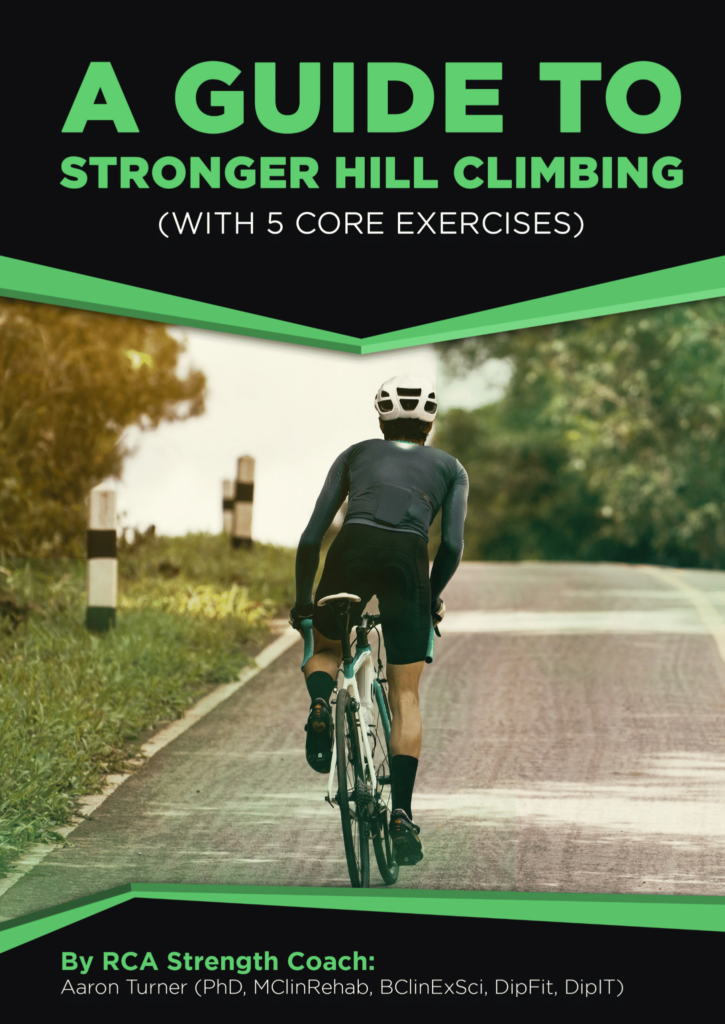
FAQs
How do you train for climbing cycling?
Perform hill repetitions, practise steep hills, and long climbs, and ride at low and high cadences. Also, add variety and focus on consistency in your training for the best results.
What makes a bike better at climbing?
While it’s mainly about the rider, your bike plays a factor in your performance. Choosing lighter wheels and a better bike geometry (that matches your riding style) will also improve your climbing.
Is cycling uphill good for you?
Yes! Cycling uphill will build muscular strength and endurance, anaerobic and aerobic power, and more.
References:
- Abt, J.P., Smoliga, J.M., Brick, M.J., Jolly, J.T., Lephart, S.M. and Fu, F.H., 2007. Relationship between cycling mechanics and core stability. The Journal of Strength & Conditioning Research, 21(4), pp.1300-1304.
- Gilmer, G., Washington, J. and Oliver, G., 2018. Assessment of lumbopelvic–hip complex instability and segmental sequencing amongst softball athletes. International Biomechanics, 5(1), pp.36-45.
- Louis, J., Hausswirth, C., Easthope, C. and Brisswalter, J., 2012. Strength training improves cycling efficiency in master endurance athletes. European journal of applied physiology, 112(2), pp.631-640.
- Marsh, A.P. and Martin, P.E., 1997. Effect of cycling experience, aerobic power, and power output on preferred and most economical cycling cadences. Medicine and Science in Sports and Exercise, 29(9), pp.1225-1232.
- Millet, G.P., Tronche, C., Fuster, N. and Candau, R., 2002. Level ground and uphill cycling efficiency in seated and standing positions. Medicine and Science in Sports and Exercise, 34(10), pp.1645-1652.
- Paton, C.D., Hopkins, W.G. and Cook, C., 2009. Effects of low-vs. high-cadence interval training on cycling performance. The Journal of Strength & Conditioning Research, 23(6), pp.1758-1763.
- San Emeterio, C., Cochrane, D., Guillén-Rogel, P. and Marín, P.J., 2022. Short-term effects of lumbopelvic complex stability training in elite female road cyclists. Journal of Musculoskeletal & Neuronal Interactions, 22(1), p.62.
- San Emeterio, C., Menéndez, H., Guillén-Rogel, P. and Marin, P.J., 2021. Effect of cycling exercise on lumbopelvic control performance in elite female cyclists. Journal of Musculoskeletal & Neuronal Interactions, 21(4), p.475.
- Sunde, A., Støren, Ø., Bjerkaas, M., Larsen, M.H., Hoff, J. and Helgerud, J., 2010. Maximal strength training improves cycling economy in competitive cyclists. The Journal of Strength & Conditioning Research, 24(8), pp.2157-2165.
- Tanaka, H., Bassett Jr, D.R., Swensen, T.C. and Sampedro, R.M., 1993. Aerobic and anaerobic power characteristics of competitive cyclists in the United States Cycling Federation. International journal of sports medicine, 14(06), pp.334-338.
- Vikmoen, O., Ellefsen, S., Trøen, Ø., Hollan, I., Hanestadhaugen, M., Raastad, T. and Rønnestad, B.R., 2016. Strength training improves cycling performance, fractional utilization of VO2max and cycling economy in female cyclists. Scandinavian Journal of Medicine & Science in sports, 26(4), pp.384-396.

